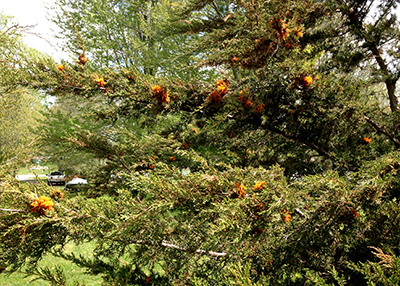Creepy, orange fungus attacking junipers
Cedar-apple rust fungi looks creepy, but rarely causes significant damage to junipers.

Each spring, rainfall brings out the best in plants in our forests and landscapes. Fresh, colorful foliage emerges and the world transforms before our eyes. If you are looking closely, for about one week each spring during the rainy weather you will also see something magical happen in our native cedar (juniper) trees. A bright orange, gelatinous blossom that kind of looks like Raggedy Ann’s hair adorns the cedars-like Christmas decorations. While common fungi, including morels, have been popping up everywhere, this fungus expands with the warm rainfall to exhibit many “squid-like tentacles” that are sure to delight the curious.
Cedar-apple rust is the common name for the disease caused by the fungus Gymnosporangium juniperi-virginianae. It rarely causes significant damage to the junipers (cedar) where it lives for half of its life. According to Jan Byrne, plant pathologist for Michigan State University Plant & Pest Diagnostics, the weather we have been experiencing is just right for this science fiction-looking fungus to show up.
In the past week or so, the woody galls have bloomed with the gelatinous fruiting structures. This phase of the fungus is known as the telial stage and it is even more interesting to touch. As a mom, anything that replicates ooze, silly putty or other slimy substance can be the best entertainment the outdoors provides.

From a science perspective, rust fungi lead interesting lives. This one alternates between two hosts, according to Byrne. The big, orange, “Jell-O fingers” produced on the cedar in May give rise to tiny spores that are carried by wind to the alternate host—an apple or hawthorn. The gall on the cedar will quickly dry up and hang on the tree for several years.
Although this disease does not threaten the health of the cedar, it can prematurely defoliate non-resistant apples, crab apples and hawthorn where it lands and completes it life cycle later this summer. Leaves will first show a classic spot that typically is bright orange to yellow with a lighter, outer ring. The underside of the leaf may show light colored, cup-shaped structures. Fruit can also be disfigured.
For the most part, this disease is more of a curiosity than a threat to either plant. However, in some instances, it does warrant a control strategy. If you have a valued hawthorn or crab apple, MSU Extension suggests removing the alternate host (cedar) that is in close proximity as an option. Since fungicides will not eradicate the blooming gelatinous galls, a more likely solution is to prune out the galls in the cedar this fall to avoid infection next spring, according to Byrne.
Most landscape junipers show a fair amount of genetic resistance. The most affected plants are the Eastern red cedars that grow prolifically along the roadside. When using hawthorn or crabapple in new landscapes, take note if there is a large population of wild cedars in nearby areas.



 Print
Print Email
Email

